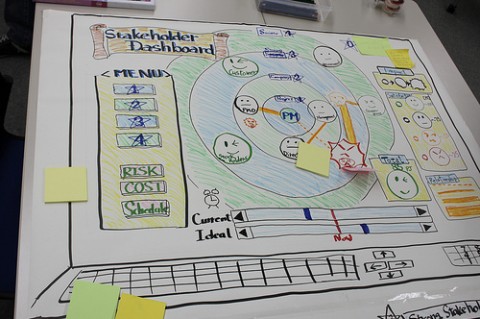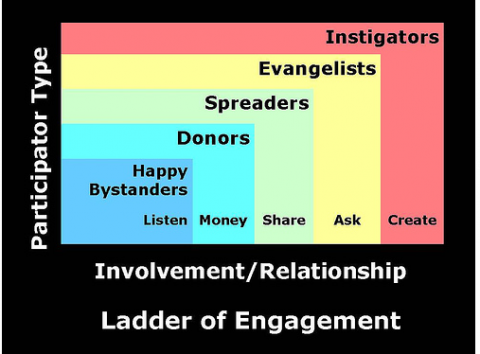Tag Archive: transparency
June 20, 2013
Thanks to Harold Jarche for turning me on to this beta codex network presentation about seeing and designing organizations as networks. It captures much of the learning that has been coming out of our work at IISC with different kinds and scales of networks for social change. Below is a list of ten key points from the presentation: Read More
May 22, 2013

I am just coming from a convening of the Northern New England Networks Community of Practice in Crawford Notch, New Hampshire. The theme of the gathering was “Power and Networks,” and very timely in that a few network building initiatives with which I am working are reaching a fever pitch in terms of working out issues of power and privilege. Borrowing from something my IISC colleague Cynthia Silva Parker has said in the past, while power is always at the table, now it’s on the table! And I wanted to share some of the gleanings from the overall session. Read More
March 27, 2013

|Photo by TREEAID|http://www.flickr.com/photos/53871588@N05/5726759624|
This post is not exactly about an insurance policy, at least not in the traditional sense. Picking up on the metaphor of last week’s piece on “Network Gardening,” today we bring focus to how we can protect the early growth of networks for social change. Protect them from what? The temptation to jump to action too quickly, leapfrogging the “problem conversation,” the tendency to want to institutionalize everything (what a friend calls “incorporation fever”), naysayers, exclusionist practices, and the heavy hitters who are used to getting their way. Read More
March 20, 2013

|Photo by idleformat|http://www.flickr.com/photos/idleformat/2062534673|
An interesting innovation I’ve seen recently in the realm of network building for social change is the creation of what is being called, in one particular system with which I am working, the “Network Support Team.” In the context of what has emerged to this point as an “alignment network” focused on state-wide food system development and addressing community food insecurity, this volunteer team has stepped forward to help “tend to the whole.” It functions much as a good gardener would in her attempts to nurture abundance and flourishing. As this network considers movement into a more action/production-oriented mode, here is how the NST is helping the garden to grow: Read More
March 7, 2012
 Blogging this morning from the Building Energy Conference, New England’s most established cross-disciplinary renewable energy and green building gathering. If you are here, come visit us at our IISC booth! One of the big topics of this year’s conference and trade show is thinking in terms of systems. In this spirit, the following post draws from an email that I recently sent to the convenor of a state-wide system change initiative that is poised to identify strategic points of leverage within the system and its component systems to nudge it in the direction of serving all people equitably in the state and ensuring community food security. Related to this goal is the desire to support a more robust local economy and to work synergistically with ecosystems. I believe the questions listed pertain to any complex dynamic system change effort, whether one is talking about food, education, or community energy use and production, and I welcome your thoughts . . . Read More
Blogging this morning from the Building Energy Conference, New England’s most established cross-disciplinary renewable energy and green building gathering. If you are here, come visit us at our IISC booth! One of the big topics of this year’s conference and trade show is thinking in terms of systems. In this spirit, the following post draws from an email that I recently sent to the convenor of a state-wide system change initiative that is poised to identify strategic points of leverage within the system and its component systems to nudge it in the direction of serving all people equitably in the state and ensuring community food security. Related to this goal is the desire to support a more robust local economy and to work synergistically with ecosystems. I believe the questions listed pertain to any complex dynamic system change effort, whether one is talking about food, education, or community energy use and production, and I welcome your thoughts . . . Read More
July 21, 2011

|Photo by http2007|http://www.flickr.com/photos/http2007/2204187170|
In this week’s public Pathway to Change workshop in San Francisco, participants engaged in a practice meeting facilitated by some of their colleagues that focused on effective means of building power in collaborative change efforts to enhance their overall effectiveness to realize more just ends. The assumptions going into the conversation were that power is defined as the capacity to influence people and one’s environment, create change, address needs, pursue desires, and/or protect interests. Furthermore we suggested that power is not a fixed asset that people possess. Rather, it is socially constructed, understood, and legitimized through social relationships among individuals and groups of people. Given that it is not fixed, it can also grow or be grown.
So here is the list of ideas that surfaced for ways to build power and we certainly invite your reactions and additions (items in bold ended up being given higher priority by the group): Read More
July 14, 2011
“Tension and transparency of tension create capacity.”
-Mistinguette Smith

|Photo by ideowl|http://www.flickr.com/photos/ideowl/3737550476|
Last week I blogged from Knoll Farm in Fayson, VT, where I was serving as a co-trainer of our Whole Measures workshop, which we offer in partnership with the Center for Whole Communities. In that post I reflected on the connection that the Knoll Farm site creates between people, and between people and land. A remarkable aspect of the Farm is its intentional design, in that its human-made elements naturally work with and build upon the contours of the landscape and draw people’s attention to certain dynamics that reflect essential truths. An example is the large yurt, that sits on an outcropping at the end of an old logging road. It is a welcome (and welcoming) sight as one rounds the bend having climbed a fairly long steep incline. Its brown and green colors integrate nicely with the forested landscape, and its very structure invites one into contemplation about the life that surrounds it and with which it is in relationship. Read More
April 27, 2011

|Photo by Robert Higgins|http://www.flickr.com/photos/37893534@N07/4779016818|
“Stakeholder” is a big word in our practice at IISC. When it comes to our collaborative change work, we take stakeholder analysis very seriously, in certain situations spending a few days to complete this critical task. The aim is generally to surface the names of those groups and individuals who as a sum total will help to ensure that we have the system represented in the room. What this means is pushing people, at times, into uncomfortable places to consider typically unheard voices and those they have outright resisted inviting to the table but without whom they could not hope to make the kind of change to which they aspire.
Typically we engage in a conversation with our clients and partners that asks them identify, in the context of some given change effort, those whose stakes are defined in the following ways: Read More
February 2, 2011

|Image from cambodia4kidsorg|http://www.flickr.com/photos/cambodia4kidsorg/2296887265|
I’ve been working with a couple of organizations and initiatives lately as they discuss enhancing their strategies for stakeholder engagement. Throughout all of this work is the emerging awareness that we are in the midst of a paradigm shift in our field with respect to what engagement means and looks like. This, of course, has been captured by many writers and thinkers who have been looking closely at what social media is enabling (see, for example, Clay Shirky’s work, the Working Wikkily blog, or the writings of Beth Kanter and Allison Fine). And at the same time there is a realization that this is not just about technology, but a return to some of what we’ve forgotten as well as a step towards something new. Read More




 Blogging this morning from the
Blogging this morning from the 


